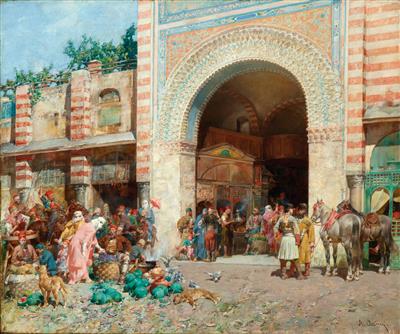Alberto Pasini

(Busseto 1826–1899 Cavoretto)
Oriental Market in front of a Portal, signed A. Pasini, oil on canvas, 46 x 55 cm, framed
Provenance:
Galleria Fogliato, Turin, 1953;
acquired from the above by the father of the current owner,
Private Collection Italy.
Exhibited:
Turin, Galleria d’Arte della “Gazzetta del Popolo”, 1949;
Turin, Galleria Fogliato, 1952.
Catalogued and illustrated in:
Probably Archives Boussod et Valadon as “Une grande porte d’un Bazar”, 1892;
A. Ferrero, 1898, p. 5;
A. Ferrero in “l’Illustrazione Italiana”, 1900, p. 26;
Marco Calderini, Turin, E. Celanza ed., 1916, ill. 47;
Catalogue Galleria d’Arte della “Gazzetta del Popolo”, Turin 1949, no. 1;
Marziano Bernardi, Alberto Pasini e G. B. Quadrone, SEI ed., Turin 1949, ill. 1;
Galleria Fogliato, Turin, cat. no. 8, 1953, no. 101;
Vittoria Botteri Cardoso, Pasini, Sagep ed., Genua 1991, p. 373, no. 873.
The Entrance of a Bazaar sees the artist choose a bustling market scene that portrays a snippet of everyday life. The image depicts a handful of people outside a bazaar, trading goods and conversing with one another. Alberto Pasini shows a woman with her parasol open, for instance, while another is buying a watermelon. Dogs and horses are also present, as in nearly every outdoor composition. The scene is set in summer, as the abundance of green watermelon and the blue sky attest. Alberto Pasini was captivated by local colour. The women are draped in shades of pink and yellow and veiled in white, in contrast to the men, who are dressed in light brown.
In 1854, Alberto Pasini moved to Paris to join Theodore Chassériau’s studio. It was there that he became fascinated by orientalist subjects. Pasini first travelled to the Middle East in 1855, accompanying the French minister and diplomat Nicolas Prosper Bourée. He travelled to Tehran, through Egypt, and then returned through Armenia and Turkey. He produced numerous sketches, plein-air studies of figures and architecture. In 1867, he left for Istanbul to join Prosper Bourée, who had been appointed as the French Ambassador. He would return in 1876 to work on a series of paintings commissioned by Sultan Abdul Aziz for the Dolmabahçe Palace. Pasini was a regular contributor to the annual Salon. His gallerist in Paris, Goupil, placed more than 500 of his orientalist pictures into private and gallery collections across Europe and America. He settled in Italy in 1870. He either painted from memory or from drawings and notes that he had made en plein air during his travels. He is now considered to be one of the finest orientalist painters.
Video: The Orientalists
Esperto: Gautier Gendebien
 Gautier Gendebien
Gautier Gendebien
+39-334-777 1603
Gautier.Gendebien@dorotheum.it
08.06.2020 - 16:00
- Stima:
-
EUR 150.000,- a EUR 200.000,-
Alberto Pasini
(Busseto 1826–1899 Cavoretto)
Oriental Market in front of a Portal, signed A. Pasini, oil on canvas, 46 x 55 cm, framed
Provenance:
Galleria Fogliato, Turin, 1953;
acquired from the above by the father of the current owner,
Private Collection Italy.
Exhibited:
Turin, Galleria d’Arte della “Gazzetta del Popolo”, 1949;
Turin, Galleria Fogliato, 1952.
Catalogued and illustrated in:
Probably Archives Boussod et Valadon as “Une grande porte d’un Bazar”, 1892;
A. Ferrero, 1898, p. 5;
A. Ferrero in “l’Illustrazione Italiana”, 1900, p. 26;
Marco Calderini, Turin, E. Celanza ed., 1916, ill. 47;
Catalogue Galleria d’Arte della “Gazzetta del Popolo”, Turin 1949, no. 1;
Marziano Bernardi, Alberto Pasini e G. B. Quadrone, SEI ed., Turin 1949, ill. 1;
Galleria Fogliato, Turin, cat. no. 8, 1953, no. 101;
Vittoria Botteri Cardoso, Pasini, Sagep ed., Genua 1991, p. 373, no. 873.
The Entrance of a Bazaar sees the artist choose a bustling market scene that portrays a snippet of everyday life. The image depicts a handful of people outside a bazaar, trading goods and conversing with one another. Alberto Pasini shows a woman with her parasol open, for instance, while another is buying a watermelon. Dogs and horses are also present, as in nearly every outdoor composition. The scene is set in summer, as the abundance of green watermelon and the blue sky attest. Alberto Pasini was captivated by local colour. The women are draped in shades of pink and yellow and veiled in white, in contrast to the men, who are dressed in light brown.
In 1854, Alberto Pasini moved to Paris to join Theodore Chassériau’s studio. It was there that he became fascinated by orientalist subjects. Pasini first travelled to the Middle East in 1855, accompanying the French minister and diplomat Nicolas Prosper Bourée. He travelled to Tehran, through Egypt, and then returned through Armenia and Turkey. He produced numerous sketches, plein-air studies of figures and architecture. In 1867, he left for Istanbul to join Prosper Bourée, who had been appointed as the French Ambassador. He would return in 1876 to work on a series of paintings commissioned by Sultan Abdul Aziz for the Dolmabahçe Palace. Pasini was a regular contributor to the annual Salon. His gallerist in Paris, Goupil, placed more than 500 of his orientalist pictures into private and gallery collections across Europe and America. He settled in Italy in 1870. He either painted from memory or from drawings and notes that he had made en plein air during his travels. He is now considered to be one of the finest orientalist painters.
Video: The Orientalists
Esperto: Gautier Gendebien
 Gautier Gendebien
Gautier Gendebien
+39-334-777 1603
Gautier.Gendebien@dorotheum.it
|
Hotline dell'acquirente
lun-ven: 10.00 - 17.00
kundendienst@dorotheum.at +43 1 515 60 200 |
| Asta: | Dipinti dell’Ottocento |
| Tipo d'asta: | Asta in sala |
| Data: | 08.06.2020 - 16:00 |
| Luogo dell'asta: | Wien | Palais Dorotheum |
| Esposizione: | 27.05. - 08.06.2020 |

